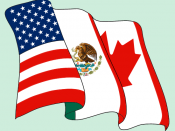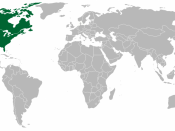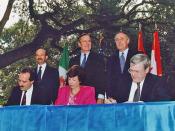NAFTA, the North American Free Trade Agreement
Introduction
The North American Free Trade Agreement was an inevitable step in the evolution of the United States economic policy. The globalization of the world economy due to technological advances in computers and communications has shrunk the world to the point where no single country acting alone can effectively compete on the foreign market. Even the United States, with its vast resources, can not have an absolute advantage in all things that it produces. It does not have unlimited factors of endowments and must do its best to make these available to the companies within its borders. There are two basic sides to the argument over the North American Free Trade Agreement. This research paper will concentrate on analyzing these two sides and answers the question whether NAFTA should be expanded or not.
History of NAFTA
"NAFTA, which includes Canada, the United States, and Mexico, went into effect in 1994, but it originated with the Canada-U.S. Free Trade Agreement" (Daniels and Radebaugh 248.)
In 1988, the United States and Canada agreed to enter into a free trade agreement. This went into effect on January 1, 1989 and was widely accepted as a logical course of action. Canada is a highly developed nation and has a lot in common with the United States. Its per capita income and hourly wages are equivalent to the U.S. and has long been considered our brother to the north. Then in 1991, Mexico entered into talks with Canada and the United States that concluded on 17 December 1992. The treaty was ratified and came into effect on 1 January 1994. The agreement's major objectives are to eliminate tariffs, to improve market access to the goods and services among NAFTA countries, to eliminate barriers to manufacturing, agricultural...


